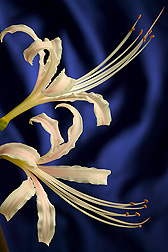Introducing Lycoris to U.S. Flower Lovers
For more than 20 years ARS horticulturist Mark Roh has been intrigued by the origins and habitats of the exotic and beautiful Lycoris.
Though various Lycoris species have been grown as ornamentals in China, Korea, and Japan for many centuries, only two species are readily available here: L. squamigera and L. radiata. They—and the rarer L. incarnata, L. chejuensis, and L. flavescens—are maintained at the U.S. National Arboretum (USNA), in Washington, D.C., and in Beltsville, Maryland.
In 1984, Roh collected several unidentified Lycoris species from Anduck Valley, on Korea’s Jeju Island. This subtropical area hosts about 4,000 species of plants. Then in 1998, more Lycoris species were collected in Japan, Korea, and China.
DNA molecular markers and chromosome studies proved that some of the unidentified Lycoris collected from Anduck Valley were L. incarnata, a species previously known to be native only to China. It is possible that this accession was brought from China to Korea by bulb collectors, but no record of that can be found.
|
|
In the past 6 years, extensive visits to areas near Anduck Valley have been made by Roh or by collaborators Mun Seok Seong, of Jeju-do Agricultural Research and Extension Services, and Yong Bong Park, of Jeju National University. But they have failed to locate any more L. incarnata there. They’ve only observed the Jeju Island native, L. chejuensis.
It’s possible that L. incarnata bulbs were introduced deliberately or that a small population of L. incarnata might indeed have been native to Anduck Valley. If L. incarnata was previously native to Jeju Island, it is assumed that it is now locally extinct. If L. incarnata was introduced and can naturally hybridize with L. chejuensis, new species of hybrid origin could evolve; but then the genetic purity of L. chejuensis could be a concern.
Preserving germplasm at different locations will make it possible to maintain valuable materials permanently and allow sharing of the germplasm for future genetic studies. The 1984 collection of L. incarnata from Jeju Island and maintenance at USNA will guarantee proper preservation of this valuable germplasm for future generations. L. incarnata germplasm has been returned to Jeju-do, and bulbs will be planted in the Anduck Valley for restoration.
Roh has been able to study and successfully propagate various Lycoris species not before seen in this hemisphere. He has hybridized Lycoris, and the new hybrid could eventually be released as new cultivars.
All collected Lycoris germplasm is now maintained in USNA’s Asian Collections by Carole Bordelon, of the Gardens Unit, and in the greenhouse of the Floral and Nursery Plants Research Unit in Beltsville, where Roh works. Some newly introduced species bloomed for the first time at the arboretum in the summer of 2005.
|
|
A Pleasant Surprise
All Lycoris species have beautiful or unusual features that make them unique. It is affectionately called the “surprise lily” because of its rarity in this country and its elaborate flowering pattern. Its flower stalk measures about 10 to 20 inches tall with six to nine red, yellow, or white frilly flowers. Only the flower stalk projects from the ground when the plant is blooming. Resistant to pests, it’s also a very durable bulb, tolerating the extremes of drought and waterlogging, as well as poor soil conditions.
L. radiata was a popular plant in old southern U.S. gardens. Its small, narrow, straplike, blue-green leaves die away in early spring. Then, in August, a 15- to 20-inch spike shoots up from underground, which is why it is sometimes called the “resurrection lily.” Also called the red spider lily or red hurricane lily, it’s topped with a complex, bright-red flower with many very long stamens.
Unusual—Even Magical
The strange thing about L. radiata and other Lycoris is that they don’t flower every year, frustrating many growers. “This is a very interesting plant,” says Bordelon. “Visitors to the arboretum really like it. It’s not often you see something like this, a red plant without leaves.”
Blooms of L. squamigera, often called “magic lily,” are sometimes found around old houses, where they grow under big shade trees. In their native China, Japan, and Korea, wild species grow in shady woodlands, so USNA—home to thousands of trees—is a perfect location for this species. L. squamigera is grown throughout the arboretum grounds. The rare species, such as L. chinensis, L. chejuensis, and L. flavescens, could add even more beauty to USNA’s gardens, once cold hardiness is tested.
“Lycoris is not well-known by the American public,” says Roh. “We hope that by putting some of these new species on display, we can show Americans the beauty of this plant. This will perhaps encourage them to grow Lycoris for themselves.”—By Alfredo Flores, Agricultural Research Service Information Staff.
This research is part of Plant, Microbial, and Insect Genetic Resources, Genomics, and Genetic Improvement, an ARS National Program (#301) described on the World Wide Web at www.nps.ars.usda.gov.
Mark S. Roh is in the USDA-ARS Floral and Nursery Plants Research Unit, 10300 Baltimore Ave., Bldg. 010A, Beltsville, MD 20705; phone (301) 504-5659, fax (301) 504-5096.
"Introducing Lycoris to U.S. Flower Lovers" was published in the December 2005 issue of Agricultural Research magazine.









